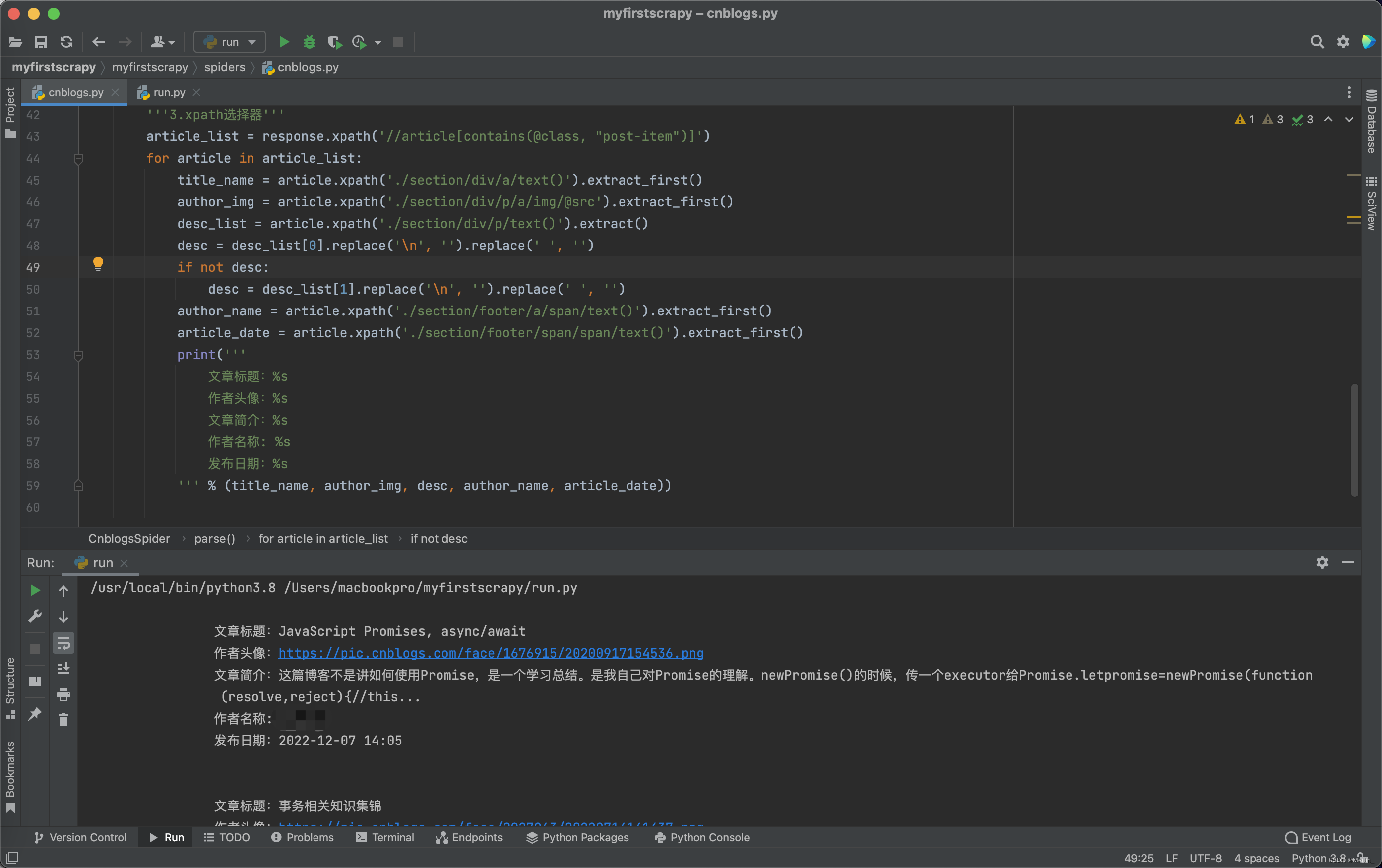一、Scrapy架构流程介绍
Scrapy一个开源和协作的框架,其最初是为了页面抓取 (更确切来说, 网络抓取 )所设计的,使用它可以以快速、简单、可扩展的方式从网站中提取所需的数据。但目前Scrapy的用途十分广泛,可用于如数据挖掘、监测和自动化测试等领域,也可以应用在获取API所返回的数据(例如 Amazon Associates Web Services ) 或者通用的网络爬虫。
Scrapy 是基于twisted框架开发而来,twisted是一个流行的事件驱动的python网络框架。因此Scrapy使用了一种非阻塞(又名异步)的代码来实现并发。整体架构大致如下:

官网链接:https://docs.scrapy.org/en/latest/topics/architecture.html
官方原文解释:
The data flow in Scrapy is controlled by the execution engine, and goes like this:
- The Engine gets the initial Requests to crawl from the Spider.
(引擎从Spider获取要爬行的初始请求。) - The Engine schedules the Requests in the Scheduler and asks for the next Requests to crawl.
(引擎在调度器中对请求进行调度,并要求对下一个请求进行爬取。) - The Scheduler returns the next Requests to the Engine.
(调度器将下一个请求返回给引擎。) - The Engine sends the Requests to the Downloader, passing through the Downloader Middlewares (see process_request()).
(引擎将请求发送给下载器,通过下载器中间件(请参阅process_request())。) - Once the page finishes downloading the Downloader generates a Response (with that page) and sends it to the Engine, passing through the Downloader Middlewares (see process_response()).
(一旦页面完成下载,Downloader就会生成一个响应(使用该页面)并将其发送给引擎,通过Downloader中间件传递(请参阅process_response())。) - The Engine receives the Response from the Downloader and sends it to the Spider for processing, passing through the Spider Middleware (see process_spider_input()).
(引擎从下载器接收响应,并通过Spider中间件将其发送给Spider进行处理(参见process_spider_input())。) - The Spider processes the Response and returns scraped items and new Requests (to follow) to the Engine, passing through the Spider Middleware (see process_spider_output()).
(Spider处理响应,并通过Spider Middleware(参见process_spider_output())将抓取的项和新的请求返回给引擎。) - The Engine sends processed items to Item Pipelines, then send processed Requests to the Scheduler and asks for possible next Requests to crawl.
(引擎将处理过的项目发送到项目管道,然后将处理过的请求发送到调度器,并请求抓取可能的下一个请求。) - The process repeats (from step 1) until there are no more requests from the Scheduler.
(该过程重复(从步骤1开始),直到没有来自Scheduler的更多请求。)
大致解释意思为:
引擎(EGINE)
引擎负责控制系统所有组件之间的数据流,并在某些动作发生时触发事件。有关详细信息,请参见上面的数据流部分。
调度器(SCHEDULER)
用来接受引擎发过来的请求, 压入队列中, 并在引擎再次请求的时候返回. 可以想像成一个URL的优先级队列, 由它来决定下一个要抓取的网址是什么, 同时去除重复的网址
下载器(DOWLOADER)
用于下载网页内容, 并将网页内容返回给EGINE,下载器是建立在twisted这个高效的异步模型上的
爬虫(SPIDERS)--->在这里写代码
SPIDERS是开发人员自定义的类,用来解析responses,并且提取items,或者发送新的请求
项目管道(ITEM PIPLINES)
在items被提取后负责处理它们,主要包括清理、验证、持久化(比如存到数据库)等操作
下载器中间件(Downloader Middlewares)
位于Scrapy引擎和下载器之间,主要用来处理从EGINE传到DOWLOADER的请求request,已经从DOWNLOADER传到EGINE的响应response,
你可用该中间件做以下几件事:设置请求头,设置cookie,使用代理,集成selenium
爬虫中间件(Spider Middlewares)
位于EGINE和SPIDERS之间,主要工作是处理SPIDERS的输入(即responses)和输出(即requests)
二、Scrapy解析数据(爬取Cnblogs文章信息)
import scrapy
from bs4 import BeautifulSoup
class CnblogsSpider(scrapy.Spider):
name = 'cnblogs'
allowed_domains = ['www.cnblogs.com']
start_urls = ['http://www.cnblogs.com/']
"""
response类似于requests模块的response对象 print(response.text就能拿到结果)
以下总共展示三种方法: 1.使用Bs4 2.使用css解析 3.xpath选择器
"""
def parse(self, response):
'''方式1.使用Bs4'''
soup = BeautifulSoup(response.text, 'lxml')
article_list = soup.find_all(class_='post-item')
for article in article_list:
title_name = article.find(name='a', class_='post-item-title').text
print(title_name)
'''方式2.使用css解析'''
article_list = response.css('article.post-item')
for article in article_list:
title_name = article.css('section>div>a::text').extract_first() # extract_first()一条 extract()全部
author_img = article.css('p.post-item-summary>a>img::attr(src)').extract_first()
desc_list = article.css('p.post-item-summary::text').extract() # 这个时候取一条回报错 需要把日志功能打开
desc = desc_list[0].replace('\n', '').replace(' ', '')
if not desc:
desc = desc_list[1].replace('\n', '').replace(' ', '')
author_name = article.css('footer.post-item-foot>a>span::text').extract_first()
article_date = article.css('footer.post-item-foot>span>span::text').extract_first()
print('''
文章标题:%s
作者头像:%s
文章简介:%s
作者名称: %s
发布日期:%s
''' % (title_name, author_img, desc, author_name, article_date))
'''3.xpath选择器'''
article_list = response.xpath('//article[contains(@class, "post-item")]')
for article in article_list:
title_name = article.xpath('./section/div/a/text()').extract_first()
author_img = article.xpath('./section/div/p/a/img/@src').extract_first()
desc_list = article.xpath('./section/div/p/text()').extract()
desc = desc_list[0].replace('\n', '').replace(' ', '')
if not desc:
desc = desc_list[1].replace('\n', '').replace(' ', '')
author_name = article.xpath('./section/footer/a/span/text()').extract_first()
article_date = article.xpath('./section/footer/span/span/text()').extract_first()
print('''
文章标题:%s
作者头像:%s
文章简介:%s
作者名称: %s
发布日期:%s
''' % (title_name, author_img, desc, author_name, article_date))

三、Settings相关配置提高爬取效率
基础配置
1.是否遵循爬虫协议
ROBOTSTXT_OBEY = False # 正常来说你都来爬虫了 还遵循 ?
2.LOG_LEVEL 日志级别
LOG_LEVEL='ERROR' # 可以查看具体信息 不会显示无效信息
3.USER_AGENT # 电脑UA版本信息
user-agent: Mozilla/5.0 (Macintosh; Intel Mac OS X 10_15_7) AppleWebKit/537.36 (KHTML, like Gecko) Chrome/108.0.0.0 Safari/537.36
4.默认请求头
DEFAULT_REQUEST_HEADERS = {
'Accept': 'text/html,application/xhtml+xml,application/xml;q=0.9,*/*;q=0.8',
'Accept-Language': 'en',
}
5.爬虫中间件
SPIDER_MIDDLEWARES = {
'cnblogs.middlewares.CnblogsSpiderMiddleware': 543,
}
6.下载中间件
DOWNLOADER_MIDDLEWARES = {
'cnblogs.middlewares.CnblogsDownloaderMiddleware': 543,
}
7.持久化配置
ITEM_PIPELINES = {
'cnblogs.pipelines.CnblogsPipeline': 300,
}
8.爬虫项目名称
BOT_NAME = 'myfirstscrapy'
9.指定爬虫类的Py文件的位置
SPIDER_MODULES = ['myfirstscrapy.spiders']
NEWSPIDER_MODULE = 'myfirstscrapy.spiders'
增加爬虫的爬取效率
1.增加并发量
# 默认scrapy开启的并发线程为32个,可以适当进行增加。在settings配置文件中修改
CONCURRENT_REQUESTS = 100
2.降低日志级别
# 在运行scrapy时,会有大量日志信息的输出,为了减少CPU的使用率。可以设置log输出信息为INFO或者ERROR即可。
LOG_LEVEL = 'INFO'
3.禁止Cookie
# 如果不是真的需要cookie,则在scrapy爬取数据时可以禁止cookie从而减少CPU的使用率,提升爬取效率。
COOKIES_ENABLED = False
4.禁止重试
# 对失败的HTTP进行重新请求(重试)会减慢爬取速度,因此可以禁止重试。
RETRY_ENABLED = False
5.减少下载超时
# 如果对一个非常慢的链接进行爬取,减少下载超时可以能让卡住的链接快速被放弃,从而提升效率。
DOWNLOAD_TIMEOUT = 10 # 超时时间为10s
四、持久化方案
方案1:保存到本地文件
# 把得到的数据直接保存到本地文件
import scrapy
class CnblogsSpider(scrapy.Spider):
name = 'cnblogs'
allowed_domains = ['www.cnblogs.com']
start_urls = ['http://www.cnblogs.com/']
def parse(self, response):
data_list = []
article_list = response.xpath('//article[contains(@class, "post-item")]')
for article in article_list:
title_name = article.xpath('./section/div/a/text()').extract_first()
author_img = article.xpath('./section/div/p/a/img/@src').extract_first()
desc_list = article.xpath('./section/div/p/text()').extract()
desc = desc_list[0].replace('\n', '').replace(' ', '')
if not desc:
desc = desc_list[1].replace('\n', '').replace(' ', '')
author_name = article.xpath('./section/footer/a/span/text()').extract_first()
article_date = article.xpath('./section/footer/span/span/text()').extract_first()
print('''
文章标题:%s
作者头像:%s
文章简介:%s
作者名称: %s
发布日期:%s
''' % (title_name, author_img, desc, author_name, article_date))
data_list.append({
'title_name': title_name, 'author_img': author_img, 'desc': desc, 'author_name': author_name,
'article_date': article_date
})
return data_list
'''
这个时候在控制台输入存放的位置即可(json pickle csv)三种格式可选
scrapy crawl cnblogs -o '文件名称.后缀'
'''
方案2:保存到数据库
整体流程
- 使用pipline 常用的,管道形式,可以同时存到多个位置的
- 在items.py中写一个类(相当于写Django的表模型)继承scrapy.Item
- 在类中写属性写字段 所有字段都是scrapy.Field类型(title = scrapy.Field())
- 在爬虫中导入类 实例化得到对象 把要保存的数据放到对象中( item[‘title’] = title )
- 修改配置文件 指定pipline 数字表示优先级,越小越大
(ITEM_PIPELINES = { ‘crawl_cnblogs.pipelines.CrawlCnblogsPipeline’: 300 }) - 写一个piplinel类
open_spider: 数据初始化,打开文件,打开数据库链接
process_item:真正存储的地方一定不要忘了return item,交给后续的pipline继续使用
close_spider:销毁资源,关闭文件,关闭数据库链接
cnblogs.py
import scrapy
from myfirstscrapy.items import CnblogsItem
class CnblogsSpider(scrapy.Spider):
name = 'cnblogs'
allowed_domains = ['www.cnblogs.com']
start_urls = ['http://www.cnblogs.com/']
def parse(self, response):
# item = CnblogsItem() # 外面定义 会有问题
article_list = response.xpath('//article[contains(@class, "post-item")]')
for article in article_list:
item = CnblogsItem() # 放在里面每次循环都是新的
title_name = article.xpath('./section/div/a/text()').extract_first()
author_img = article.xpath('./section/div/p/a/img/@src').extract_first()
desc_list = article.xpath('./section/div/p/text()').extract()
desc = desc_list[0].replace('\n', '').replace(' ', '')
if not desc:
desc = desc_list[1].replace('\n', '').replace(' ', '')
author_name = article.xpath('./section/footer/a/span/text()').extract_first()
article_date = article.xpath('./section/footer/span/span/text()').extract_first()
item['title_name'] = title_name
item['author_img'] = author_img
item['desc'] = desc
item['author_name'] = author_name
item['article_date'] = article_date
yield item
items.py
import scrapy
class CnblogsItem(scrapy.Item):
title_name = scrapy.Field()
author_img = scrapy.Field()
desc = scrapy.Field()
author_name = scrapy.Field()
article_date = scrapy.Field()
article_content = scrapy.Field()
settings.py
ITEM_PIPELINES = {
'myfirstscrapy.pipelines.CnblogsFilesPipeline': 300,
'myfirstscrapy.pipelines.CnblogsMysqlPipeline': 200, # 数字越小 等级越高
}
pipelines.py
import pymysql
class CnblogsMysqlPipeline: # 名称需要跟settings中配置一样
def open_spider(self, spider):
self.conn = pymysql.connect(
user='root',
password="123",
host='127.0.0.1',
database='cnblogs',
port=3306,
autocommit=True, # 自动提交数据
)
self.cursor = self.conn.cursor()
def process_item(self, item, spider):
self.cursor.execute( # 不要直接使用字符串拼接 会有风险
'insert into article (title_name, author_img, `desc`, author_name, article_date) values (%s,%s,%s,%s, %s)',
args=[item['title_name'], item['author_img'], item['desc'], item['author_name'], item['article_date']])
# self.conn.commit() # 提交数据
return item
def close_spider(self, spider):
self.cursor.close()
self.conn.close()
class CnblogsFilesPipeline:
def open_spider(self, spider):
self.f = open('cnblogs.txt', 'at', encoding='utf-8')
print('开始了')
def process_item(self, item, spider):
self.f.write('文章标题:%s, 文章作者: %s \n' % (item['title_name'], item['author_name']))
return item
def close_spider(self, spider):
self.f.close()
print('结束啦')
五、爬虫中间件
Scrapy的所有中间件都写在Middlewares.py中 跟Djagno非常像做一些拦截
爬虫中间件
MyfirstscrapySpiderMiddleware
def process_spider_input(self, response, spider): # 进入爬虫会执行它
def process_spider_output(self, response, result, spider): #从爬虫出来会执行它
def process_spider_exception(self, response, exception, spider): #出了异常会执行
def process_start_requests(self, start_requests, spider): #第一次爬取执行
def spider_opened(self, spider): #爬虫开启执行
返回值:
return a Response object:正常,会进入到引擎,引擎把它给爬虫
return a Request object: 会进入到引擎,引擎把它放到调度器中,等待下次爬取
raise IgnoreRequest 会执行process_exception
下载中间件
MyfirstscrapyDownloaderMiddleware
def process_request(self, request, spider): # request对象从引擎进入到下载器会执行
def process_response(self, request, response, spider): # response对象从下载器进入到引擎会执行
def process_exception(self, request, exception, spider): #出异常执行它
def spider_opened(self, spider): #爬虫开启执行它
返回值
return None: 继续执行下面的中间件的process_request
return a Response object: 不进入下载中间件了,直接返回给引擎,引擎把它通过6给爬虫
return a Request object:不进入中间件了,直接返回给引擎,引擎把它放到调度器中
raise IgnoreRequest: process_exception() 抛异常,会执行process_exception
技术小白记录学习过程,有错误或不解的地方请指出,如果这篇文章对你有所帮助请
点点赞收藏+关注谢谢支持 !!!






















 834
834











 被折叠的 条评论
为什么被折叠?
被折叠的 条评论
为什么被折叠?










